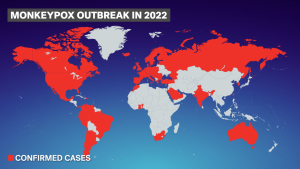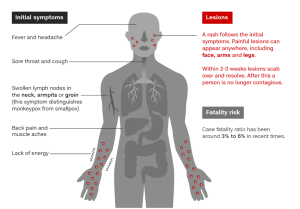Spread of monkeypox virus outbreak slows

Monkeypox on dark skin.
Monkeypox is a disease that is much similar to smallpox.
There have been more than 25,000 monkeypox cases in the United States during the current outbreak, says CNN News, but deaths among monkeypox patients has been rare with only three deaths in the U.S. at the time of publication.
The first US death due to monkeypox was in Los Angeles County in September. Another person with monkeypox in Houston died in August. On September 29, Ohio reported its first death.
 Across the world, there have been more than 68,000 monkeypox cases and 25 deaths, according to the World Health Organization (WHO).
Across the world, there have been more than 68,000 monkeypox cases and 25 deaths, according to the World Health Organization (WHO).
Most people infected so far have had underlying health conditions or compromised immune systems.
Prior to this current global outbreak, according to Medlineplus.org, in the past, most people who got Monkeypox lived in central and western Africa. An article from the World Heath Organization (WHO) says that Monkeypox started in 1980. Monkeypox spread mainly from a wide variety of rodent species.
Researchers started a program that tracks diseases by taking samples from sewers. Of the 41 communities from 10 different states that were sampled, 22 of those had the monkeypox virus detected according to TIME. The program is led by researchers at Stanford University, Emory University, and Verily.
There are two stages of the Monkeypox symptoms: the invasion period and then the skin eruption.
 The invasion period is characterized by fever, intense headache, swelling of lymph nodes, back pain, muscle aches, and intense asthenia. According to WHO, swelling of the lymph nodes (lymphadenopathy) is a distinctive feature compared to other diseases that may initially appear similar such as chicken pox, measles, and smallpox.
The invasion period is characterized by fever, intense headache, swelling of lymph nodes, back pain, muscle aches, and intense asthenia. According to WHO, swelling of the lymph nodes (lymphadenopathy) is a distinctive feature compared to other diseases that may initially appear similar such as chicken pox, measles, and smallpox.
The skin eruption begins within 1-3 days of the appearance of fever. WHO states that the rash is more concentrated on the face and extremities rather than on the trunk. In 95% of cases, the face, hands, and the soles of feet are affected. Other commonly-affected areas are the insides of the mouth and the eyes. In severe cases, the lumps can get bigger and bigger until sections of skin slough off.
To prevent monkeypox, the best thing to do is get the vaccine and take medicines to prevent any sickness and stay clean. According to WHO, the vaccine is a two-dose vaccination but availability is limited and it is only 85% effective in stopping Monkeypox. But WHO notes that the vaccine may result in “milder illness.”
Most cases have resulted from animal to human transmission. Contact with wild animals, especially those that are sick or dead, is a main cause. Foods containing animal parts must be thoroughly cooked to also avoid animal to human transmission. Some of the most-infected animal species are rope squirrels, tree squirrels, Gambian pouched rats, primates, and dormice.
Some places are taking steps to keep Monkeypox contained. Some countries have put in place regulations restricting importing rodents and primates. Examples of these regulations include that captive animals be quarantined, handled with precautions and observed for Monkeypox symptoms for 30 days.

According to an article at Reuters.com, Egypt has discovered its first Monkeypox case. The victim is a 42-year old Egyptian man who lives in Europe. The health ministry said in a statement, the 42-year-old man was isolated in a hospital and his condition was stable.”
So far only three cases of Monkeypox have been discovered in the United States, reported by ABC news.






